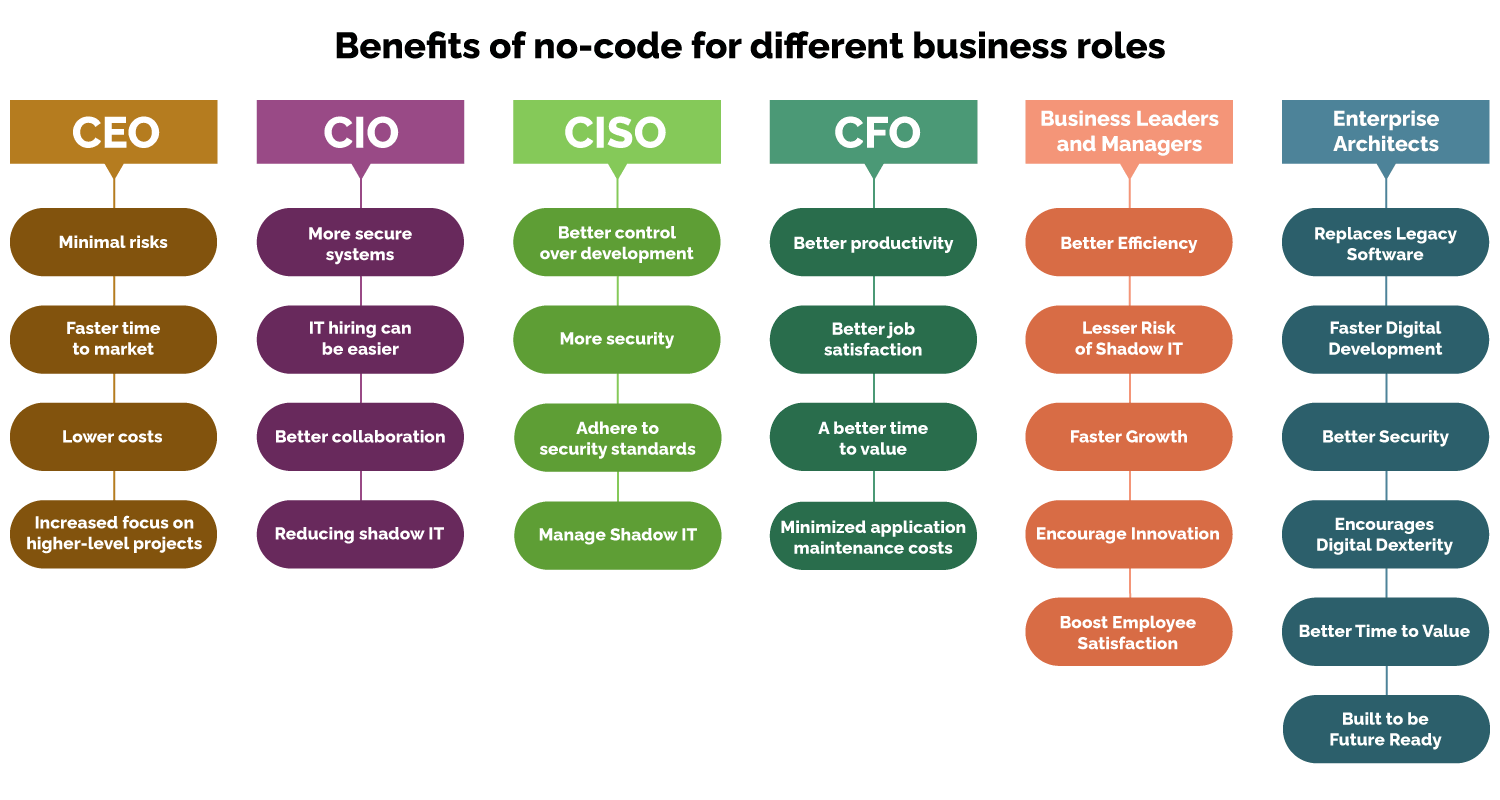
No-code is on the rise, and the number of different applications and platforms using this technology only proves its popularity. Over 65% of all development will take place on low-code no-code (LCNC) development platforms by 2025 according to Gartner. However, no-code can also seem confusing, costly, and poorly scalable to nontechnical people who don’t know the benefits of it. As this form of development is relatively new, there can be several misconceptions associated with it and we’re here to clear all of them up.
By 2025, over 65% of all application development will take place on low-code no-code (LCNC) development platforms
Source: Gartner
Benefits of No-Code for Business Leaders
Here are a few benefits of no-code that can help your business leaders understand the advantages of no-code application development.

How can I justify no-code to a CEO?
Your CEO is going to be concerned with how this technology can help the company grow and innovate to get an edge over your competitors. Figuring out how this form of development can encourage fruitful collaboration and ensure revenue growth will be key to getting approval to go forward. While remaining competitive is a priority, the CEO will also want to mitigate the risks of a new project as much as possible. Here are a few benefits of no-code that might help convince your CEO:
Minimal risks: No-code platforms and application development can reduce the number of people and systems involved in the creation of a tool or workflow. This can lead to a reduced number of risks when it comes to delays or forgotten business requirements. The lesser the number of actively involved members, the lesser the chance of issues with the project on the whole.
Faster time to market: No-code builders are able to develop and create your ideas much faster than traditional development. This leads to a faster time to market as well as an easier method to create initial builds and versions. This can lead to faster revenue generation and thus your application can add to your total revenue much more quickly.
Lower costs: With IT spend accounting for a significant amount of total revenue, no-code is a feasible, cost-effective way of reducing this. The cost of maintenance and small changes to maintain the systems can be severely reduced once you switch to a no-code platform. You can instead invest in resources for more high-level projects.
Increased focus on higher-level projects: High-value projects can get pushed to the side for similar but more pressing problems. Your skilled engineers should be focusing their talents entirely on contributing to the higher value projects that can drive growth in your business. No-code platforms can free up their time and allow other employees to solve smaller problems on their own.
Explore: Quixy for CEO
How can I justify no-code to a CIO?
CIOs will be on the lookout for any solution that can improve your current operations and streamline and accelerate your delivery processes. They will also be looking for a solution that can help satisfy the needs of the internal team without leaving the organization open for any data related attacks or requiring a large amount of external help to function. With digital transformation on their mind, here are a few benefits that can help convince a CIO that no-code is for you:
More secure systems: Most no-code applications and platforms have security features built-in which can solve the security issue. These platforms can help simplify many processes and projects by having built-in features to help keep information and data secure. In this case, you don’t have to settle for a subpar solution to your problems.
IT hiring can be easier: No-code platforms are built to make it easier for users to learn how to use them. Due to this, it’s possible to widen the candidate pool for the IT department as new employees could be trained to use the platform in a few weeks. Your employees won’t need to learn for years about building enterprise-grade programs with hand-coding, instead, they can use efficient no-code application development platforms.
Better collaboration: No-code can bridge the gap between the IT department and the business leaders in terms of what they want to execute. Business users can be a part of the requirement conversations as no-code platforms help with executing ideas without any last-minute changes.
Reducing shadow IT: Shadow IT is a problem for most large organizations as many unauthorized IT projects are funded and pursued without the knowledge of the IT department. No-code can help stop this by implementing a faster application development process thus freeing up the IT department to pay attention to other projects.
Explore: Quixy for CIO
How can I justify no-code to a CISO?
A CISO is always going to be mainly concerned with keeping the information and data of the company secure. As cyberthreats become more dangerous, vetting each new software before approval, and being aware of any potential threats has become a necessity. The CISO also needs to ensure that the company complies with the rules regarding the collected data. Shadow IT is also an omnipresent issue that the CISO needs to keep a handle on. Keeping all of these security concerns in mind, here are a few no-code benefits that could add to the security measures set by the CISO:
Better control over development: No-code platforms can help curb the errant development of unnecessary applications due to the lack of an editable codebase. This can provide better control over the development process on an organization-wide scale.
More security: Nowadays no-code platforms are built with security in mind. Especially with platforms that are built to support enterprise-grade systems and applications, security is a cornerstone of the application development platform. Your information and data can remain properly secure throughout the scaling of the systems and organizations.
Adhere to security standards: No-code platforms that comply with the safety standards are much more secure and come with a certificate to prove it. Information security and privacy remain a priority along with security controls at every step. Having the proper certifications like the ISO/IEC 27001:2013 and being compliant with SOC 2 Type 2 can help further prove that the security measures of the applications are up to the mark.
Also Read: From Coding to Strategic Leadership: Quixy Levels Up Your IT Game
Manage Shadow IT: No-code tools often used visual drag-and-drop builders to help their users build applications. This prevents users from introducing any new code into the application which could become a future safety concern. Shadow IT is using and developing any software without the IT team knowing about it. Shadow IT can become a large security risk as it is unregulated development. No-code tools can help eradicate this problem by providing users with a safe environment to create the applications that they need.
Explore: Quixy for CISO

How can I justify no-code to a CFO?
Innovation is a key solution for CFOs, meaning no-code is a great fit. The CFO needs to keep an eye on compliance with current codes, manage any technical debt, allocate the IT budget effectively, and reduce the risk of failure in projects. No-code can be a great help in the organization without requiring an exorbitant amount of investment, which is why the CFO could benefit from the following points:
Better productivity: No-code platforms can help you make the most out of your budgets. A robust no-code platform can allow new users to quickly learn the basics of the system and allow them to develop the tools they need to be more productive. This platform can also allow highly skilled engineers to simultaneously work on more high-level projects, thus saving time and money.
Also Read: From Coding to Strategic Leadership: Quixy Levels Up Your IT Game
Better job satisfaction: A no-code platform can eliminate most tedious and time-consuming tasks that can make IT employees unhappy with their jobs. This can help the employees feel more fulfilled and productive, which can lead to better retention of your IT employees.
A better time to value: Whenever delays or obstacles hinder a project from being completed on schedule, this can lead to financial loss. This negative revenue impact can be avoided by using no-code tools which can simplify processes and ensure that projects are completed on time and within budget.
Minimized application maintenance costs: No-code tools are fast, efficient and cost-effective. Outdated legacy applications that are used by companies can lead to high costs and cause loss of time due to high maintenance requirements. This can reduce the employees’ productivity and quickly drain the IT budget. If this legacy software is migrated to no-code tools, it will definitely be better for the IT budget and productivity.
Explore: Quixy for CFO
How can I justify no-code to Business Leaders and Managers?
Nowadays, there is a constant demand for innovation and growth, especially in the technological landscape. Business leaders and managers may find it difficult to keep up with the trends and timelines, especially if they have to depend on the IT team to meet their objectives constantly. No-code can help lessen this dependency by allowing business unit users to utilize no-code to create custom-built applications to suit their specific needs. This can simultaneously lessen the burden on the IT team, so it’s a win-win situation!
Here are a few ways in which no-code can benefit business leaders and managers:
Better Efficiency: No-code enables business managers to automate and streamline their processes in the department, without depending on the IT team. This also allows business managers to quickly change and modify processes, leading to more efficient workflows.
Lesser Risk of Shadow IT: If a business unit user is given free rein to create a custom-built application, it might result in a security violation and further data security issues. Using a secure no-code platform can prevent this with built-in guide rails and governance from IT, thus allowing the business leader to achieve their goals without the security risks.
Faster Growth: With a no-code application, everybody in the department is given a chance to take part in creating an application. As a result of this, applications can be developed 10X faster, which can lead to better productivity and faster growth across the department.
Encourage Innovation: In today’s tech world, innovation is the key to staying ahead. Instead of staying bound to just the knowledge of the IT department, no-code can give everyone the chance to create and build the tools they need by democratizing development in a fraction of the time. This can encourage inputs from individuals who have other domain knowledge, which might lead to a novel innovative solution.
Boost Employee Satisfaction: Retaining an employee is better than recruiting and training another employee which can be an expensive and time-consuming process. No-code can help employees eliminate repetitive and mundane tasks through automation which can lead to a direct increase in employee satisfaction, better productivity, and more collaboration.
Explore: Quixy for Business Leaders & Managers
How can I justify no-code to Enterprise Architects?
Enterprise architects are key to ensuring that the digital operations and systems are aligned with the strategic business objectives. They are in charge of maintaining and developing the IT infrastructure to allow the company to pivot and use different strategies to stay ahead of the competitors. An enterprise architect may have to constantly rework and tweak the existing IT infrastructure which can take a lot of time and result in frustration while building applications. No-code can help architects create the custom applications that they need without a lot of hand-coding which can free up their time. Also, if the no-code applications are integrated with existing systems, this can prevent the issues that may arise with legacy systems and software. Here are a few ways in which no-code may benefit enterprise architects:
Replaces Legacy Software: Legacy software is known for being time-consuming and difficult to maintain. No-code can help enterprise architects rapidly create tools and applications that require less maintenance.
Faster Digital Development: No-code invites everyone in a team to work together to create the applications and tools that they need, leading to accelerated digital innovation at speeds 10X that of traditional development. This agility, along with seamless integration, can help reduce data and application silos from occurring, thus spurring on faster development of digital applications.
Better Security: Encouraging employees to create applications could lead to security risks and a lack of data security. However, when you use a no-code platform, they are generally equipped with built-in safety features to prevent any issues. Along with granular access control, your data can be safe and secure especially if the no-code vendor has certifications like ISO/IEC and SOC 2.
Encourages Digital Dexterity: Judging from reports and projections, citizen developers will far outnumber professional developers in a business by 2024. This statistic means that existing systems need to primed to allow citizen developers to create the application that they need quickly. This is where no-code platforms can help as they provide a secure and customizable platform for application development.
Better Time to Value: Building prototypes can be time-consuming and reduce your time-to-market with every iteration. No-code can help businesses create MVPs rapidly, leading to faster testing and eventually faster deployment of the offering. It can also eliminate project delays, save on development costs, and improve the profit margin.
Built to be Future Ready: No-code platforms can help you build applications ready for the future as they can be modified easily. As long as the no-code vendor can provide the basic enterprise requirements, developing on that platform implies that you will be ready for whatever may come in the future in the tech and digital space.
Explore: Quixy for Architects
Summary
No-code tools are the way to go for most organizations and it’s time your organization hops on the bandwagon too. Understandably, your executives might be hesitant to adopt such an innovation, but after explaining the numerous benefits, there’s a better chance that you can start using the best no-code tool for your needs. No-code application development platforms can change the game and provide a competitive advantage for your company, especially if you use them to supplement your digital transformation efforts in your company.
At Quixy, we aim to find a way to solve your problems using our intuitive visual platform. We can help you create the application or tools you need without hand-coding. No-code uses abstraction to allow you to assemble the tool you need, which means that no-code can help in every department at your organization. Don’t miss out on the chance to elevate your processes. Take the first step and get started with Quixy today.
Subscribe
Login
Please login to comment
0 Comments
Oldest















